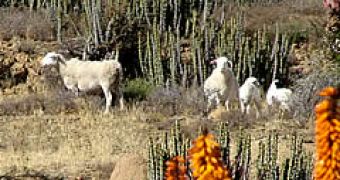You may have heard about the South African veld, an arid plane. Velds can be of many types, and noorsvelds refer to those where the dominant vegetation consists of noors (Euphorbia species), succulent and thorny plants, the ecological variant for cacti in Africa. But the noorsveld is a ranching area where Angora goats are raised for their extremely fine wool called mohair.
But this is a semidesert area with extremely arid winters, which is why the question is: how does this industry flourish here? The sweet or blue noor (Euphorbia coerulescens) makes over 40% of their winter diet. The goats learn how to avoid the thorns and even to break off the plants using their horns, for easier feeding. Goats can also eat the plants growing between noors, but this is risky as the fine Angora wool can get entangled in the thorns and under the hot summer sun a goat can die in two hours.
But the fact is that the veld is struck from time to time by severe droughts and noors make the difference between life and death of the livestock. Now, stockbreeders go with cutting machines connected to tractors to cut the noors into small pieces, easy to be eaten by goats. This way wild fauna benefits from it too, like the large kudu antelopes.
The smaller red-spined noor (Euphorbia ferox) is covered by so many thorns that normally no animal can reach the edible stems. But now this species is more important, as it is more resistant to drought than the blue noor. Now, the ranchers and day laborers have to go from bush to bush burning the thorns with blowtorches or using other techniques, so that once the thorns are burnt, the livestock can devour the stems - springboks too take advantage of this.

 14 DAY TRIAL //
14 DAY TRIAL //